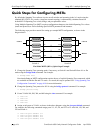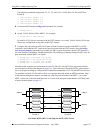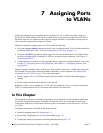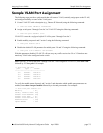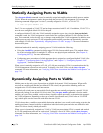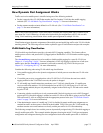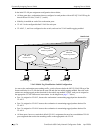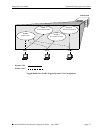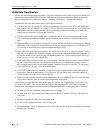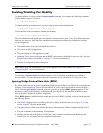
Statically Assigning Ports to VLANs Assigning Ports to VLANs
page 7-4 OmniSwitch 6600 Family Network Configuration Guide April 2006
Statically Assigning Ports to VLANs
The vlan port default command is used to statically assign both mobile and non-mobile ports to another
VLAN. When the assignment is made, the port drops the previous VLAN assignment. For example, the
following command assigns port 2 on slot 3, currently assigned to VLAN 1, to VLAN 755:
-> vlan 755 port default 3/2
Port 3/2 is now assigned to VLAN 755 and no longer associated with VLAN 1. In addition, VLAN 755 is
now the new configured default VLAN for the port.
A configured default VLAN is the VLAN statically assigned to a port. Any time the vlan port default
command is used, the VLAN assignment is static and a new configured default VLAN is defined for the
port. This command is also the only way to change a non-mobile port VLAN assignment. In addition, non-
mobile ports can only retain one VLAN assignment, unlike mobile ports that can dynamically associate
with multiple VLANs. See “Dynamically Assigning Ports to VLANs” on page 7-4 for more information
about mobile ports.
Additional methods for statically assigning ports to VLANs include the following:
• Using the vlan 802.1q command to define tagged VLANs for non-mobile ports. This method allows
the switch to bridge traffic for multiple VLANs over one physical port connection. (See Chapter 11,
“Configuring 802.1Q,” for more information.)
• Configuring ports as members of a link aggregate that is assigned to a configured default VLAN. (See
Chapter 12, “Configuring Static Link Aggregation,” and Chapter 13, “Configuring Dynamic Link
Aggregation,” for more information.)
When a port is statically assigned to a VLAN, a VLAN port association (VPA) is created and tracked by
VLAN management software on each switch. To display a list of all VPAs, use the show vlan port
command. For more information, see “Verifying VLAN Port Associations and Mobile Port Properties” on
page 7-19.
Dynamically Assigning Ports to VLANs
Mobile ports are the only types of ports that are eligible for dynamic VLAN assignment. When traffic
received on a mobile port matches pre-defined VLAN criteria, the port and the matching traffic are
assigned to the VLAN without user intervention.
By default, all switch ports are non-mobile (fixed) ports that are statically assigned to a specific VLAN
and can only belong to one default VLAN at a time. The vlan port mobile command is used to enable
mobility on a port. Once enabled, switch software classifies mobile port traffic to determine the appropri-
ate VLAN assignment. Depending on the type of traffic classification used (VLAN rules or VLAN ID
tag), mobile ports can also associate with more than one VLAN.
VLANs do not have a mobile or non-mobile distinction and there is no overall switch setting to invoke the
mobile port feature. Instead, mobility is enabled on individual switch ports and rules are defined for indi-
vidual VLANs to classify mobile port traffic.
When a port is dynamically assigned to a VLAN, a VLAN port association (VPA) is created and tracked
by VLAN management software on each switch. To display a list of all VPAs, use the show vlan port
command. For more information, see “Verifying VLAN Port Associations and Mobile Port Properties” on
page 7-19.



